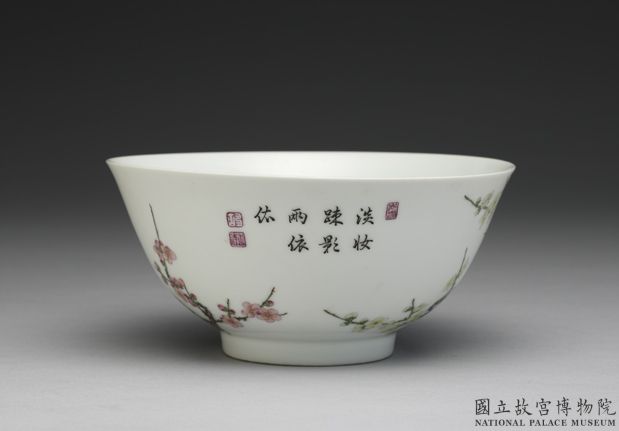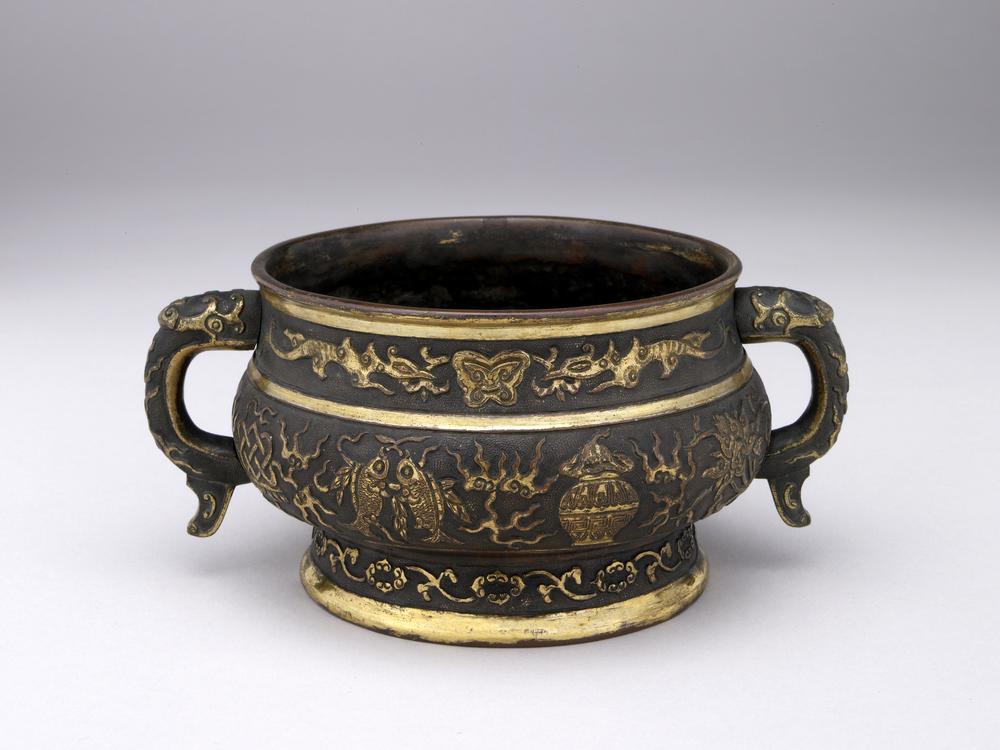Period:Ming dynasty Production date:1540-1566 (circa)
Materials:porcelain
Technique:glazed, underglazed,
Subjects:fountain kirin
Dimensions:Height: 31.80 centimetres Width: 20.80 centimetres (with spout and handle)
Description:
Porcelain ewer decorated in underglaze blue. Of similar form to BM Franks.149, this ewer has a rounded body, dish mouth, high spreading foot, long straight spout supported by an angled strut with curlicue terminals fixed to the neck, and a handle with a looped attachment at the top. Painted in rich cobalt blue on either side is a fountain with a ‘qilin’ at its base, around the foot are stylized waves, encircling the neck are plantain leaves and the base is marked with a white hare on a blue ground within a double circle. Hexagonal lid with floral panels and foliate knob, marked ‘150’ and associated with the ewer, though it doesn’t seem to match.
IMG
![图片[1]-ewer BM-Franks.150-China Archive](https://chinaarchive.net/Ming dynasty/Ceramics/mid_00355725_001.jpg)
![图片[2]-ewer BM-Franks.150-China Archive](https://chinaarchive.net/Ming dynasty/Ceramics/mid_00265151_001.jpg)
![图片[3]-ewer BM-Franks.150-China Archive](https://chinaarchive.net/Ming dynasty/Ceramics/mid_00325685_001.jpg)
![图片[4]-ewer BM-Franks.150-China Archive](https://chinaarchive.net/Ming dynasty/Ceramics/mid_00355727_001.jpg)
Comments:Harrison-Hall 2001:Near Eastern brass pitchers indirectly inspired the form of this ewer. However, the decorative motifs are not found in Near Eastern art. It is likely that the ewer’s decoration has a European origin, possibly a maiolica dish, a print, painting or tapestry. Connections with Christian iconography have been established and it has been suggested that such ewers were commissioned by Jesuits in China. We know that similar ewers to the present piece found their way to Europe in the seventeenth century. One example, mounted in silver, is represented in a still-life oil painting by Wilhelm Kalf (1613-93) in the Thyssen Bornemisza Collection, Schloss Rohonsz. Similarly decorated ewers are quite common in public collections: for example, in the Victoria and Albert Museum, London; the Bastan Museum (this example was formerly in the Ardebil shrine), Iran; the Musee National des Arts Asiatiques, Guimet, Paris; Philadelphia Museum of Art, USA; Matsuda Museum, Japan; Topkapi Saray Museum, Istanbul. Only one bottle vase with this type of decoration is known from the Percival David Foundation of Chinese Art, London. A ewer of this design but with a Jiajing reign mark is in the Lee Kong Chian Art Museum, National University of Singapore.
Materials:porcelain
Technique:glazed, underglazed,
Subjects:fountain kirin
Dimensions:Height: 31.80 centimetres Width: 20.80 centimetres (with spout and handle)
Description:
Porcelain ewer decorated in underglaze blue. Of similar form to BM Franks.149, this ewer has a rounded body, dish mouth, high spreading foot, long straight spout supported by an angled strut with curlicue terminals fixed to the neck, and a handle with a looped attachment at the top. Painted in rich cobalt blue on either side is a fountain with a ‘qilin’ at its base, around the foot are stylized waves, encircling the neck are plantain leaves and the base is marked with a white hare on a blue ground within a double circle. Hexagonal lid with floral panels and foliate knob, marked ‘150’ and associated with the ewer, though it doesn’t seem to match.
IMG
![图片[1]-ewer BM-Franks.150-China Archive](https://chinaarchive.net/Ming dynasty/Ceramics/mid_00355725_001.jpg)
![图片[2]-ewer BM-Franks.150-China Archive](https://chinaarchive.net/Ming dynasty/Ceramics/mid_00265151_001.jpg)
![图片[3]-ewer BM-Franks.150-China Archive](https://chinaarchive.net/Ming dynasty/Ceramics/mid_00325685_001.jpg)
![图片[4]-ewer BM-Franks.150-China Archive](https://chinaarchive.net/Ming dynasty/Ceramics/mid_00355727_001.jpg)
Comments:Harrison-Hall 2001:Near Eastern brass pitchers indirectly inspired the form of this ewer. However, the decorative motifs are not found in Near Eastern art. It is likely that the ewer’s decoration has a European origin, possibly a maiolica dish, a print, painting or tapestry. Connections with Christian iconography have been established and it has been suggested that such ewers were commissioned by Jesuits in China. We know that similar ewers to the present piece found their way to Europe in the seventeenth century. One example, mounted in silver, is represented in a still-life oil painting by Wilhelm Kalf (1613-93) in the Thyssen Bornemisza Collection, Schloss Rohonsz. Similarly decorated ewers are quite common in public collections: for example, in the Victoria and Albert Museum, London; the Bastan Museum (this example was formerly in the Ardebil shrine), Iran; the Musee National des Arts Asiatiques, Guimet, Paris; Philadelphia Museum of Art, USA; Matsuda Museum, Japan; Topkapi Saray Museum, Istanbul. Only one bottle vase with this type of decoration is known from the Percival David Foundation of Chinese Art, London. A ewer of this design but with a Jiajing reign mark is in the Lee Kong Chian Art Museum, National University of Singapore.
© Copyright
The copyright of the article belongs to the author, please keep the original link for reprinting.
THE END





